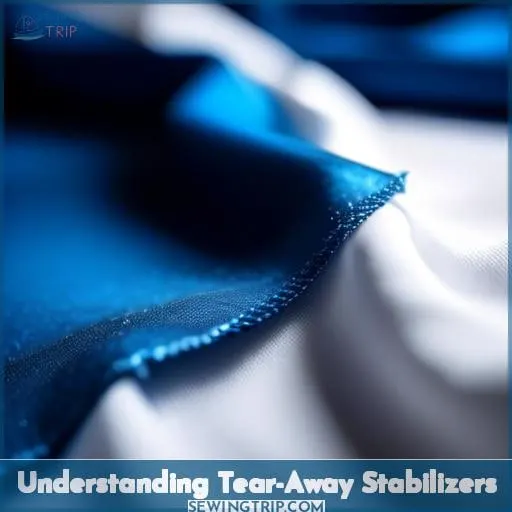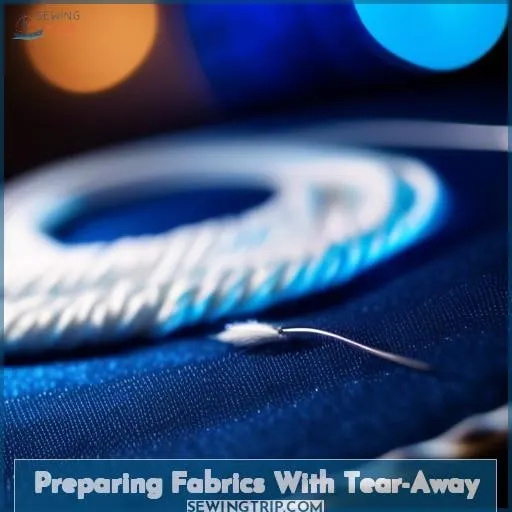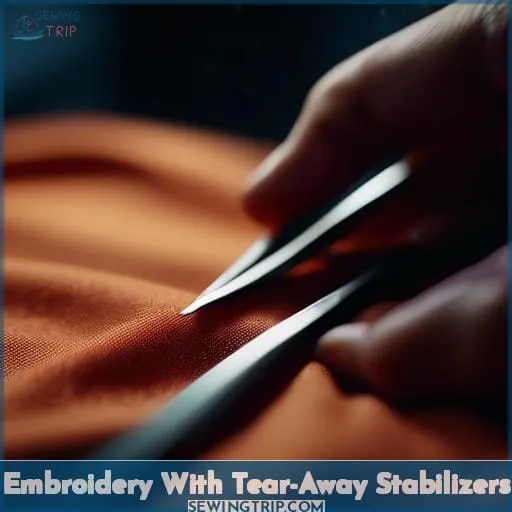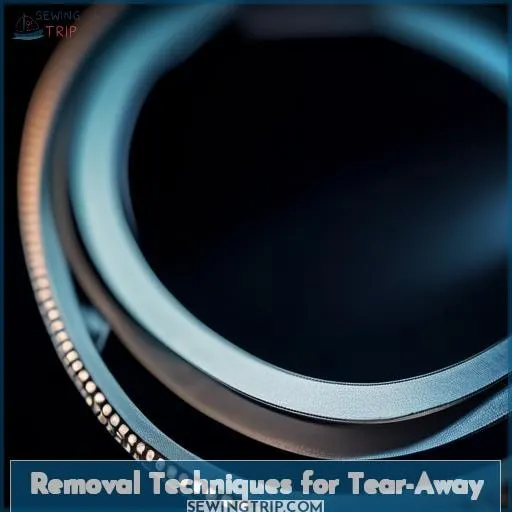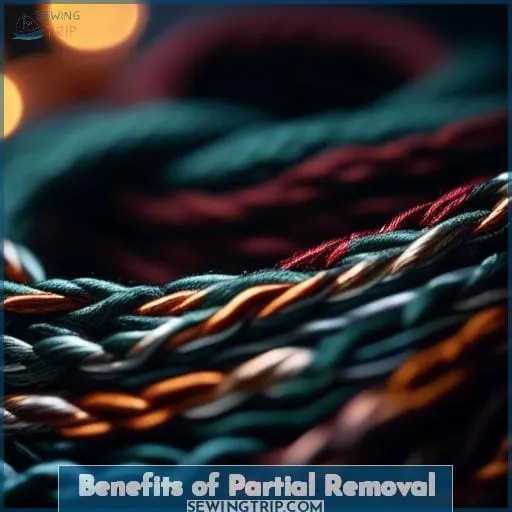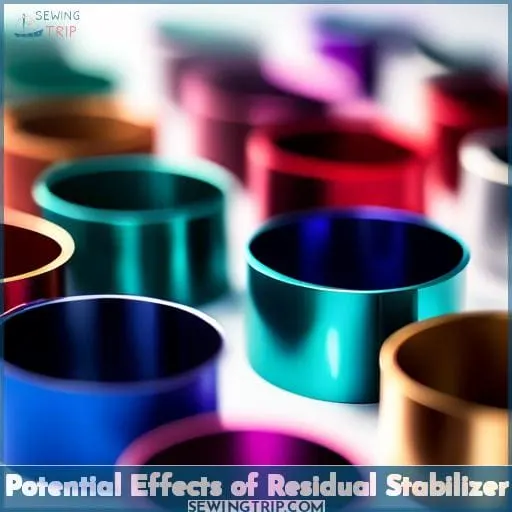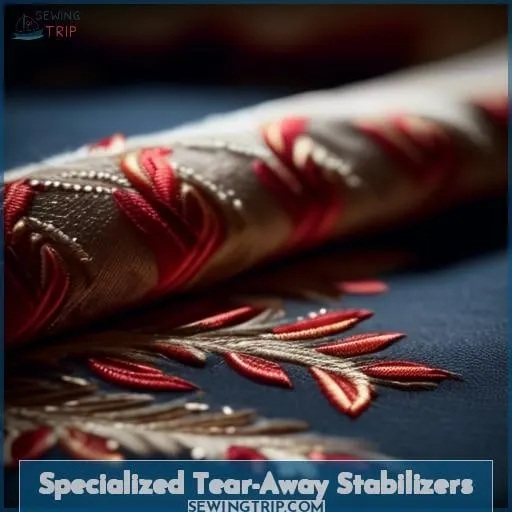This site is supported by our readers. We may earn a commission, at no cost to you, if you purchase through links.
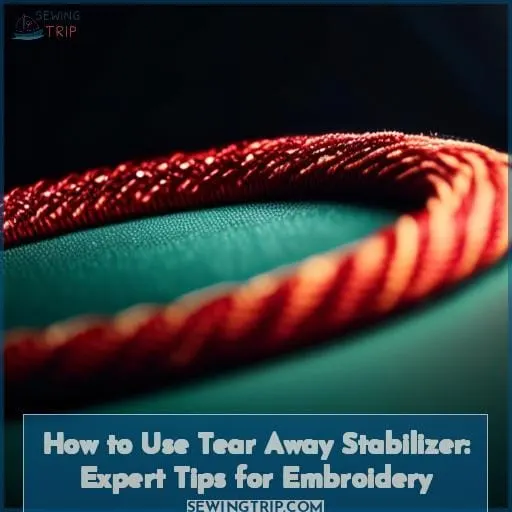
You’re about to discover how to use tear away stabilizer, a key ally in achieving crisp, clean stitches. This guide will walk you through types, weight guidelines, and removal techniques, ensuring your fabric stays pristine and your embroidery stands out.
Whether you’re innovating with fusible options or mastering delicate fabrics, tear away stabilizer is your ticket to embroidery that truly pops.
Table Of Contents
- Key Takeaways
- How to Use Tear Away Stabilizer
- Understanding Tear-Away Stabilizers
- Preparing Fabrics With Tear-Away
- Embroidery With Tear-Away Stabilizers
- Removal Techniques for Tear-Away
- Benefits of Partial Removal
- Potential Effects of Residual Stabilizer
- Specialized Tear-Away Stabilizers
- Advanced Tips for Tear-Away Use
- Frequently Asked Questions (FAQs)
- Conclusion
Key Takeaways
- Tear-away stabilizers are ideal for non-stretch fabrics like cotton and linen, and their proper placement can prevent puckering and ensure smooth stitching.
- The weight of the tear-away stabilizer should be selected based on the intricacy of the design and the stitch count, with options ranging from lightweight for simple designs to heavyweight for stitch-heavy designs.
- For removal, gentle methods such as using tweezers and needles are recommended to protect the fabric, with alternative methods like lint rollers and damp cloths also being effective.
- Specialized tear-away stabilizers, such as fusible options for added strength and water-soluble features for easy removal, are available for specific fabric types and embroidery techniques.
How to Use Tear Away Stabilizer
Yes, you can use tear away stabilizer by placing it under the fabric, embroidering your design, and then gently tearing it away from the stitches. This method is suitable for projects where you do not want the stabilizer to remain inside or be visible on the back of the project.
Understanding Tear-Away Stabilizers
When working with tear-away stabilizers, it’s crucial to understand their types and how their weight affects your embroidery project.
You’ll find that selecting the right weight is as important as the stabilizer type itself.
Types and Categories
When diving into the world of tear-away stabilizers, you’ll find a treasure trove of options to keep your embroidery projects on point.
Think of these stabilizers as the unsung heroes of the embroidery world, offering temporary support to your fabric like a best friend who’s there when you need them but knows when to step back.
You’ve got your temporary stabilizers, fusible stabilizers, and those nifty ones for design placement, softness, and stretch resistance. Each type has its own superpower, whether it’s adding stability without a long-term commitment or giving your fabric a tender touch to prevent it from stretching out like a lazy Sunday afternoon.
Weight Guidelines
Different Types of Stabilizers:
- Lightweight
- Medium Weight
- Heavyweight
Weight Guidelines:
- Light fabrics and designs with fewer stitches: Lightweight stabilizer
- Medium weight stabilizer: Versatile, good for a range of stitch counts
- Heavyweight stabilizer: Stitch-heavy designs
Timing and Removal:
- Remove the stabilizer when the dance is done
- Be gentle to avoid a crafting calamity
- Specialized products can help with tear-away removal
Weight Guidelines:
- Lightweight stabilizer: Light fabrics and designs with fewer stitches
- Medium weight stabilizer: Versatile, good for a range of stitch counts
- Heavyweight stabilizer: Stitch-heavy designs
Stabilizer Selection:
- Lightweight stabilizer: Gentle hug, enough to support but not overwhelm
- Medium weight stabilizer: Versatile, good for a range of stitch counts
- Heavyweight stabilizer: Bodyguard that ensures every stitch stays in place
Timing and Removal:
- Remove the stabilizer when the dance is done
- Be gentle to avoid a crafting calamity
- Specialized products can help with tear-away removal
Weight Guidelines:
- Lightweight stabilizer: Light fabrics and designs with fewer stitches
- Medium weight stabilizer: Versatile, good for a range of stitch counts
- Heavyweight stabilizer: Stitch-heavy designs
Preparing Fabrics With Tear-Away
When you’re getting ready to embroider, choosing the right stabilizer for your fabric is crucial.
For non-stretch fabrics like jeans or cotton, tear-away stabilizers are your go-to, providing the necessary support without being permanent.
Proper placement is key; you’ll want to ensure the stabilizer is positioned correctly to prevent puckering and allow for smooth stitching.
Suitable Fabric Types
As you’ve just learned about the different types of stabilizers, let’s dive into the fabrics that play nice with tear-away stabilizers. You’re in luck if you’re working with stable woven fabrics—think crisp cottons or that trusty linen that never lets you down.
These are the perfect candidates for a tear-away tango. But here’s a pro tip: if you’re serging a rolled hem on something as whimsical as silk chiffon, you might want to buddy up with a water-soluble stabilizer instead.
It’s like having a backstage pass—there when you need it, gone without a trace when the show’s over.
Now, imagine you’re about to embroider on a fabric that’s as stubborn as a mule. You’ll want to reach for a fusible tear-away. It’s like a gentle handshake between your fabric and the stabilizer, ensuring they stick together through thick and thin.
And for those times when you’re doing the delicate dance of design placement, sticky-back tear-away is your rhythm partner, keeping everything in step without a slip.
Remember the tear test? It’s not a high school breakup drama; it’s your go-to move to check if the stabilizer tears cleanly away without a fuss. And when you’re all set to embark on your embroidery escapade, knowing how to use tear away stabilizer is your secret weapon to avoid puckering and keep your stitches in line, just like a well-rehearsed chorus line.
Keep it smooth, keep it steady, and you’ll be the maestro of your embroidery symphony.
Stabilizer Placement Techniques
When it comes to placing your tear-away stabilizer, think of it as a backstage crew member in a play—it’s there to support the star (your fabric) without stealing the show.
First, choose a stabilizer weight that harmonizes with your fabric’s grain and weight. Too heavy, and you’ll feel like you’re wrestling a bear; too light, and it’s like bringing a knife to a gunfight.
Lay the stabilizer against the fabric, ensuring it covers the entire area to be embroidered, plus some.
When you’re done, use your tear-away removal tools gently. It’s a bit like defusing a bomb—steady hands win the race. If you leave a bit of stabilizer residue, don’t sweat it. It’s like glitter after a party; it’ll find its way out eventually.
Embroidery With Tear-Away Stabilizers
When you’re embroidering with tear-away stabilizers, it’s essential to consider the design’s intricacies and the stitch count.
The weight of the stabilizer you choose should match the density of your stitches to prevent puckering and ensure a smooth finish.
Design Considerations
When diving into the world of embroidery with tear-away stabilizers, your design’s success hinges on a few critical considerations.
Think of your embroidery area as a canvas where the right balance of stitch density and fabric drape plays a pivotal role.
Imagine hoop tension as the tightrope you walk—too tight, and your fabric might distort; too loose, and your stitches could shift.
Placement is your compass in this journey, guiding where your design will live and breathe on the fabric.
Stitch Count and Stabilizer Weight
When it comes to embroidery, the relationship between stitch count and stabilizer weight is like a dance between needle and fabric. Imagine you’re the DJ, controlling the rhythm with your machine settings, bobbin tension, stitch length, and needle size.
Your fabric type is the dance floor, and the stabilizer weight? That’s the beat keeping everything in sync.
If you’re working on a light jig with 5,000 to 7,000 stitches, a light weight tear-away stabilizer steps in, ensuring your fabric doesn’t trip over itself. As the tempo increases to 8,000 – 20,000 stitches, you’ll need a medium weight to keep the dance smooth.
And for those heavy, bass-thumping designs of 20,000+ stitches, a heavy weight stabilizer holds everything down, preventing any unwanted fabric breakdancing.
Removal Techniques for Tear-Away
When it comes to removing tear-away stabilizer after your embroidery work, patience and the right tools are key.
Tweezers and needles can be your best allies in gently picking away those stubborn bits without harming your stitches.
If you’re looking for a smoother process, alternative methods like using a lint roller or a damp cloth might just do the trick, making your embroidery project look its best.
Using Tweezers and Needles
After mastering the art of embroidery with tear-away stabilizers, it’s time to tackle the removal process with finesse. You’ll find that tweezers and needles become your best friends when dealing with delicate fabrics and intricate satin stitches.
- Gently tease out stabilizer remnants with tweezers, avoiding any tug-of-war with your precious stitches.
- Needles can pick out pesky bits without playing the villain to your fabric.
- Delicate fabrics require a soft touch; think of it as performing embroidery surgery.
- Satin stitches hide stabilizer well, but they’re not a place to stash leftovers.
- Remember, patience is a virtue; rushing can lead to stitch casualties.
Embroidery isn’t just a craft; it’s an adventure in texture and technique. As you wield your tweezers and needles like a skilled surgeon, remember that every tiny bit you remove—or decide to leave—tells a story in the tapestry of your textile masterpiece.
Keep a steady hand and a light heart, and you’ll navigate through the stabilizer jungle with the grace of a thread whisperer.
Alternative Methods
After mastering the art of using tweezers and needles to remove tear-away stabilizer, let’s dive into the world of alternative methods.
Ever found yourself in a stitch? Sometimes, the usual tools just don’t cut it. That’s where creativity kicks in. Imagine using tissue paper or a washaway stabilizer as your secret weapon against those pesky bits.
Or, think about giving your fabric a quick spritz with spray starch for that extra bit of stability.
And if you’re feeling adventurous, why not mix things up with a DIY spray starch made from stabilizer leftovers? It’s like cooking, but for sewing.
These unconventional methods aren’t just about getting the job done; they’re about exploring the endless possibilities in the art of embroidery. So, next time you’re faced with a stabilizer standoff, remember: there’s more than one way to tear away.
Benefits of Partial Removal
When you’re working with tear-away stabilizer, leaving some behind isn’t just okay—it’s actually beneficial.
This approach protects your fabric and makes removing unwanted stitches a breeze, without compromising the look of your final embroidery piece.
Protection and Ease of Stitch Removal
Diving into the art of embroidery, you’ll find that leaving some tear-away stabilizer behind is like leaving breadcrumbs for future you.
- Tear resistance becomes your fabric’s silent guardian.
- Stretch prevention keeps your designs from dancing away.
- Puckering prevention ensures your stitches sit pretty.
- Fabric protection under satin stitches becomes a hidden shield.
Impact on Final Embroidery
Leaving bits of tear-away stabilizer in your embroidery can be a game-changer, especially when you’re diving into the world of machine embroidery and decorative serging. Think of it as leaving a little guardian angel behind to watch over your stitches.
These tiny remnants act like a secret sauce, reinforcing your fabric without making a peep or a show. They’re like the unsung heroes of the embroidery world, ensuring your masterpiece remains intact, without any puckering or slipping, all while staying out of sight.
Plus, they’re kind to your skin, reducing the risk of irritation. So, next time you’re tempted to pluck every last bit out, remember, a little bit of stabilizer left behind might just be your fabric’s best friend, keeping everything snug and comfy.
Potential Effects of Residual Stabilizer
When using tear-away stabilizers for your embroidery projects, it’s important to know that while these remnants typically won’t alter the appearance of your finished piece, they could cause discomfort if they come into contact with the skin, especially if you have sensitive skin.
Over time, any leftover stabilizer pieces will soften and become less noticeable with washing, but it’s still wise to remove as much as possible to ensure the highest comfort and quality of your embroidered item.
Comfort and Skin Sensitivity
When it comes to the comfort and skin sensitivity of wearing embroidered garments, it’s crucial to consider the potential effects of residual tear-away stabilizer.
- Skin irritation: Those pesky bits of stabilizer can lead to itching faster than a mosquito at a campfire.
- Discomfort: Like a pebble in your shoe, even small remnants can be a nuisance against your skin.
- Removal sensitivity: If you’re as delicate as a butterfly’s wings, be gentle when removing stabilizer to avoid redness or soreness.
- Allergic reactions: For some, leftover stabilizer bits can be as unwelcome as a skunk at a lawn party, causing allergic responses.
Long-Term Considerations
When it comes to the long-term durability of your embroidery projects, don’t let the small stuff trip you up. Think of tear-away stabilizer bits like those tiny socks that disappear in the laundry—annoying, but not a deal-breaker.
Over time, these remnants won’t compromise your masterpiece’s integrity. However, consider storage considerations and laundry implications. If you’re like me, finding a stabilizer scrap during spring cleaning is like unearthing a relic from a bygone project.
And in the wash, those bits are like ninjas—there one minute, gone the next. But here’s the kicker: the effects on stitching quality and aesthetic impact are minimal. So, if a few bits decide to stick around, don’t sweat it. They’re just tiny reminders of your embroidery journey, not flaws in your fabric tapestry.
Specialized Tear-Away Stabilizers
When exploring specialized tear-away stabilizers, you’ll find options that fuse to your fabric. Others dissolve with water. These features can be a game-changer for your embroidery projects, offering convenience and versatility.
Fusible Options
Fusible tear-away stabilizers are like your fabric’s best buddy, keeping it in line without a fuss. Think of it as the secret agent that bonds with your fabric, providing strength without stealing the spotlight.
When you’re doing a strength comparison or durability evaluation, remember that fusible options are there to add muscle to your project. And don’t worry about breaking the bank; a cost analysis often shows they’re worth their weight in gold.
As for product recommendations, you’ll find a plethora of choices, but always look for the one that best suits your fabric’s personality.
Water-Soluble Features
Continuing from the previous discussion on fusible options, let’s dive into the world of water-soluble features in tear away stabilizers.
You’re probably wondering how these nifty little helpers can make your embroidery projects pop without leaving a trace. Well, imagine this: you’ve just finished a stunning piece, and it’s time for the big reveal.
With water-soluble stabilizers, you simply give your fabric a bath, and voilà, the stabilizer dissolves like a sugar cube in hot tea, leaving nothing but your impeccable stitches.
This type of stabilizer is a game-changer for fabric reinforcement and stabilizer removal, ensuring your embroidery stands out, not the stuff behind it. Remember, patience is key—let the water do the work, and you’ll be left with a clean, crisp finish.
Advanced Tips for Tear-Away Use
When working with delicate fabrics and sergers, it’s crucial to choose the right stabilizer to prevent puckering and ensure a clean finish.
For rolled hems on lightweight materials like silk chiffon, a stabilizer not only aids in the serging process but also enhances the appearance of the final product.
Serger Techniques on Delicate Fabrics
When tackling serger techniques on delicate fabrics like silk chiffon, it’s like walking a tightrope without a net. You’ll need a blend of curiosity, patience, and a dash of mad scientist as you dive into thread experimentation and stabilizer compatibility.
Think of your serger as a culinary artist, and the delicate fabric as a fine, temperamental ingredient. The goal? Crafting serger rolled hems that don’t just perform a function but elevate the entire piece.
Silk chiffon stabilization isn’t just about preventing mishaps; it’s about enhancing the fabric’s inherent beauty. Delicate fabric reinforcement is akin to providing a skeleton to a cloud—there, but unseen, ensuring everything holds beautifully.
So, grab your tools, and let’s embark on this journey of discovery together. Remember, the perfect recipe often comes from a bit of trial, a lot of error, and an unyielding spirit to keep pushing the boundaries.
Stabilizing Rolled Hems
When you’re aiming for that perfect rolled hem, especially on tricky fabrics like silk chiffon, stabilizer selection is key.
- Choose the right stabilizer to prevent fabric tension issues; a lightweight, fusible tear-away stabilizer can work wonders.
- Adjust your thread tension and stitch length to accommodate the delicate nature of the fabric.
- Use a fine bobbin thread to maintain the hem’s delicate appearance and feel.
Frequently Asked Questions (FAQs)
Can tear-away stabilizer be ironed onto fabric?
Yes, tear-away stabilizer can indeed be ironed onto fabric temporarily to ensure the fabric doesn’t move during embroidery.
This method is a game-changer, especially when you’re wrestling with knits or stretchy materials that like to dance away under the needle.
Just imagine it as giving your fabric a gentle, yet firm hug with an iron, ensuring everything stays put without a tango in sight.
Is tear-away suitable for multi-layered embroidery?
Given the playful challenge, let’s dive right in:
Ah, the age-old question of whether tear-away stabilizer is the knight in shining armor for your multi-layered embroidery saga.
While tear-away stabilizers might seem like the trusty sidekick, ready to tear into action, they’re more suited for simpler, less Shrek-like adventures. For those intricate, multi-layered masterpieces, you might want to court a more sophisticated stabilizer, one that doesn’t leave at the first sign of complexity.
So, in the grand tapestry of embroidery, tear-away might just be your it’s complicated relationship status.
Does tear-away stabilizer have a shelf life?
Tear-away stabilizer typically has a shelf life of 5+ years. So, you’ve got plenty of time to stitch up a storm without worry.
Keep on embroidering!
Can tear-away be used with high-speed embroidery machines?
Yes, tear-away stabilizers can be used with high-speed embroidery machines. They act like a superhero’s cape, giving your projects the power to withstand the speed and precision of these machines.
They provide excellent hoop stability for a range of stitch densities, ensuring your embroidery doesn’t shift or pucker under the rapid needlework.
Are there eco-friendly alternatives to tear-away stabilizers?
Yes, there are eco-friendly alternatives to traditional tear-away stabilizers. One such option is the INSPIRA® Fast & Easy Tear-A-Way stabilizer, made from recycled cotton fibers.
This choice not only supports environmental sustainability but also offers an easy removal process, making it a win-win for both the planet and your embroidery projects.
Conclusion
Stepping into the world of embroidery with tear away stabilizer is like unlocking a treasure chest of creative potential. You’ve learned how to choose the right type and weight for your project, and the importance of proper placement on your fabric.
You’ve seen how stabilizer weight interacts with stitch count to produce immaculate designs and discovered the finesse needed to remove it without a trace. Remember, the residual stabilizer can affect comfort, so partial removal might be your best bet.
With these expert tips, you’re now equipped to elevate your embroidery, ensuring each piece isn’t just crafted, but truly finished with care.

